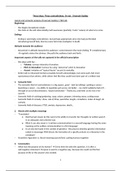Three ideas. Three contradictions. Or not. | Hannah Gadsby
Lexical and semantic analysis of Hannah Gadsby’s TED talk
Beginnings
- She begins deceptively simple
- She hints at the self-referentiality/self-awareness (partially “meta” nature) of what is to come
Endings
- Ending is seemingly contradictory, but perhaps appropriate since she had just finished
introducing herself fully. She has come full circle (metaphor in itself).
Attitude towards the audience
- Dynamism in attitude towards the audience: varies between the mock chiding complimentary
regularly states the obvious. She pulls the audience back and forth.
Important aspects of the talk not captured in the official transcription
- She plays with her…
o Volume: conveys intensity of emotion
o Pitch & intonation: humour by using “abnormal” pitch & intonation
o Accent: imitation of “typical Aussie” accent & mentality
- Entire talk is rehearsed/recited as Gadsby herself acknowledges, but some parts feel more
spontaneous than others, while others feel like they could have been part of a written text
1. Semantic field
- The semantic field of contradictions is a big aspect: good – bad (at talking); quitting a career –
launching a career – my ability to negotiate got worse, not better – my misfit suddenly had a fit –
through an act of disconnection, I found connection – Thank you, and hello (at the end of her
speech)
- Semantic field of cooking/gardening: soup, onions, prepare, trimming away, cutting away
- Semantic field of comedy: show, rule of three, punchline, laughs, comedians, make sb laugh, do
comedy
- Semantic field of diseases: PTSD, anxiety, depression, death…
2. Words with multiple meanings
- ‘Translation’
o Wat Hannah means by this word is the ability to transfer her thoughts to written speech
in an adequate and cohesive way
o What it can also mean is ‘a written communication in a second language having the same
meaning as the written communication in a first language’
o It can also be found in the context of genetics: ‘the process whereby genetic information
coded in messenger RNA directs the formation of a specific protein at a ribosome in the
cytoplasm’
- Punchline: figurative vs. literal meaning (punch/line): pulling humour together
3. Connotation
- What was the purpose of my human? Every time she asks this question, it is after a
sad/negative statement. Purpose is used in a negative way, because she could not find her
purpose of life or the answers she needed.
1





